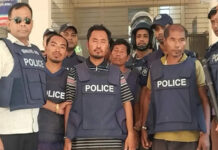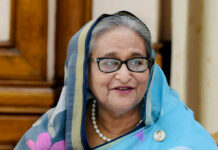Wednesday, February 25, 2009.
The morning took off just like any other day. A positive vibe was everywhere with a new government assuming office barely one and a half months ago.
Around 9:00am, the Satmasjid Road in Dhanmondi was buzzing with usual morning traffic. Shops were already busy handling customers; parents hurrying to schools to drop off their children and make it to their offices in time.
All of a sudden, a loud burst of gunfire in the Pilkhana headquarters of Bangladesh Rifles (BDR), later named as Border Guard Bangladesh (BGB), pierced through the clamour.
The gunshots baffled the neighbourhood. Initially, people thought some exercises were going on inside the BDR headquarters.
But the deep loud noise of heavy weapons continued to echo. No one could imagine that a bloody mutiny brewed up in Pilkhana which would jolt the newly formed government.
Within hours, the area turned into a battlefield with the sound of frequent firing. Inside the BDR HQ, a group of heavily armed border troops indulged in an act of mindless violence.
The mutiny that rolled on for next 33 hours left the nation benumbed, as people stood aghast at the extent of the barbarity perpetrated on the officers. It left 74 people dead, 57 of them were army officers. As things started to unfold, many theories popped up centring the mutiny.
The verdict of the mindless killing is set to be pronounced today, after over four years and nine months since the incident.
The Third Additional Metropolitan Sessions Judge’s Court, Dhaka will hand down the verdict around 10:00am. The court had earlier set October 30 for the judgment delivery.
The number of accused in the case is 846, of whom 823 are BDR jawans and 23 civilians. Of the accused, 813 are in jail, 13 on bail, four died in custody, and 20 are on the run.
The court on January 5, 2011 took into cognisance the charges of the killing case and framed charges against 850 accused on August 10 the same year. The trial started on August 24, 2011.
The mutineers chose February 25, 2009 to revolt, as the day was scheduled for the yearly Darbar (assembly) of the force on the occasion of BDR week.
As the Darbar began around 9:00am and former director general of BGB Maj Gen Shakil Ahmed was addressing the gathering of officers and lower tier personnel, some rebellious jawans created a commotion pressing for some demands including pay and benefits.
As the jawans kept on arguing, another group suddenly opened fire on the dais. The former DG was believed to be killed first.
The mutineers took many officers hostage and seized control of the headquarters within a few minutes, spraying bullets indiscriminately on the HQ compound. Thick plumes of smoke were billowing out of the headquarters.
The rumble of gunfire left the locals of neighbouring areas in panic. Army personnel reached the spot around 11:00am and took position at various points. Before them, members of the Rapid Action Battalion arrived at the scene.
Vehicular movement on nearby roads came to a halt. Shops and schools in the area were closed down. As the day wore on, many families living around Pilkhana opted to flee their homes. Those living close by watched in horror as army personnel ringed the compound and their choppers hovered overhead. The entire capital was overcome by panic.
Around 12:30pm, State Minister for LGRD and Cooperatives Jahangir Kabir Nanak and Jatiya Sangsad Whip Mirza Azam arrived at the headquarters to hold talks with the mutineers.
The mutineers talked to reporters of various television channels and newspapers demanding an end to the army’s control over the force. They demanded withdrawal of army personnel from areas around the headquarters and also talks with the prime minister and the home minister.
Around 2:00pm, Jahangir Kabir Nanak and Mirza Azam entered the headquarters with a white flag. The then home minister Sahara Khatun followed them.
Around 3:40pm, a team of mutineers reached the prime minister’s official residence ‘Jamuna’ for talks and the premier announced amnesty for the rebel soldiers following the meeting.
The mutineers stopped firing around 7:30pm and many injured including women and children were allowed to come out of the headquarters.
But around an hour later, the rebels started firing again near the gate No. 1. Additional army personnel were deployed. The mutineers put forward a condition of withdrawing the army personnel from Pilkhana by that night for laying down the arms.
Around 9:30pm, a team of four BDR members met Sahara Khatun, Jahangir Kabir Nanak, Mirza Azam and Fazle Noor Taposh at Ambala Inn on Road 2 in Dhanmondi. Eight more members joined the team within a few minutes for the talks with the government representatives.
The army personnel started retreating from their positions at New Market, Nilkhet and Balaka around 10:40pm and the meeting between the rebel personnel and the government representatives ended at 12:10am.
Taposh came up with an announcement that the rebel jawans agreed to lay down their arms within two hours.
Around 20 minutes later, Sahara Khatun again entered the border guards’ headquarters.
Through intense negotiations, the government could rescue 29 army officers: two colonels, five lieutenant colonels, 21 majors and one captain. A combined force of Rab, police and army conducted an overnight search for the rebel soldiers who had fled the site of mutiny before daybreak.
The mutinous soldiers started turning in their arms to police in presence of Sahara Khatun around 2:30am. But, within a few minutes heavy gunshots were heard and the mutineers announced to fight back if attacked. A little later, Sahara urged the soldiers to surrender their arms.
Elsewhere in the country, paramilitaries in some districts took position on the highways and roads, leaving a long stretch of border unprotected.
They came out of their camps and outposts in Chittagong, Rangpur, Chapainawabganj, Satkhira and Jessore to resist a possible military onslaught in reprisal for bloodshed at Pilkhana.
The next day around 2:00pm, Prime Minister Sheikh Hasina gave a televised speech and urged the mutineers to immediately lay down their arms and return to barracks so that she was not compelled to use force to break the standoff.
Following her speech, a convoy of armoured personnel carriers and tanks from the army’s 9 Division in Savar and 46 Brigade in Dhaka Cantonment drove into Dhanmondi area.
The arrival of the army commandos had apparently intimidated the mutineers into hoisting a white flag on the main gate of their headquarters around 6:00pm. Many fled the site through its Azimpur and Hazaribagh gates.
With the surrender of the mutineers, police and the Armed Police Battalion took control of the headquarters and its armoury in an evening push. The army with around 20 tanks and APCs took position on Satmasjid Road near the Abahani playground.
The ordeal for more than 100 family members of BDR officers and jawans — trapped inside or held hostage — finally ended. They came out with tears in their eyes.
The following day was more shocking. Army and Rab rescuers found a mass grave inside the BDR headquarters and recovered bodies of officers and the DG of the paramilitary force. The sheer scale of savagery as witnessed in the mass grave left the nation numb with grief.
Pilkhana looked like a battlefield as hundreds of thousands of bullet shells, several hundred pairs of boots and as many caps had littered the premises of the headquarters.
The government decided to form a special tribunal for trying those guilty of criminal acts during the mutiny.
Source: The Daily Star











Bangladesh court sentences 152 to death for 2009 mutiny